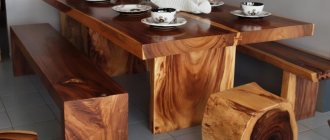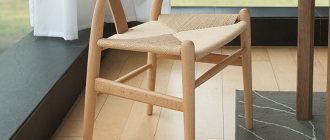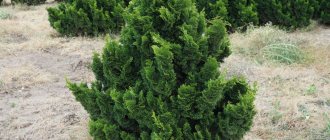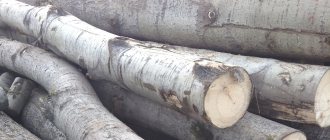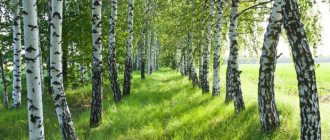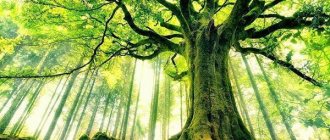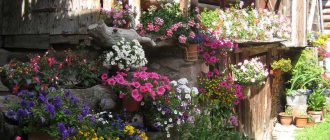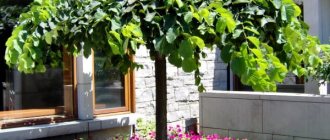Botanical description
Krupnov, usually a strongly branching tree with a huge crown and a powerful trunk. Reaches a height of 20-40 m. It can live up to 2000 years, but usually lives 300-400 years. Growth in height stops at the age of 100-200 years; growth in thickness, although insignificant, continues throughout life [2]. Probably the oldest representative should be considered the Stelmuzha oak with a trunk circumference of 13 m in Lithuania. Its age, according to various estimates, is from 700 to 2000 years.
The root system consists of a very long taproot; From the age of six to eight, lateral roots begin to develop, also going deep into the ground.
The crown is dense, tent-like or wide-pyramidal, asymmetrically spreading, with strong branches and a thick trunk (up to 3 m [3] in diameter). In young trees the trunk is irregular, geniculate, and with age it becomes straight and cylindrical. In closed plantings the crowns are smaller and the trunk is more slender (up to 1 m in diameter [3]).
The bark is dark gray, blackish, thick. In young Oak trees, the bark is gray and smooth. In the 20-30th year, more or less deep cracks form in Korea. In trees grown in freedom, the bark is up to 10 cm thick.
Young shoots are fluffy, brown or reddish-gray, shiny, with brown spots and slightly oblong lenticels.
The buds are obtusely pentagonal, 5 mm long and 4 mm wide, the lateral ones are slightly smaller and spaced apart, the scales are numerous, five-rowed, rounded, brown, glabrous and ciliated only along the edge. All buds are usually ovoid, almost spherical, light brown, rounded or bluntly pointed at the apexes, leaf scar with 7-15 marks. The apical buds are surrounded for the most part by several lateral ones.
The leaf arrangement is alternate, on the tops of the branches in the form of a bunch. The leaves are oblong, oblong-obovate, narrowed downward or heart-shaped, often with ears, the apices are obtuse or notched, pinnate, large (40-150 mm long, 25-70 mm wide), with four to seven lobes, hard, almost leathery, dark green above, shiny, yellowish or green below, with very prominent lighter veins, bare on both sides, with short petioles up to 10 mm long, always falling off in winter. The blades are blunt, rounded, the notch between them is shallow.
Flowers are dioecious. Flowering begins in trees aged 40 to 60 years, together with the blossoming of leaves, usually in May. The plant is monoecious. Staminate flowers are collected in long pendulous catkins 20-30 mm long, with ten or more flowers, two or three together or singly on the tops of last year's shoots or in the lower part of young shoots. Each flower sits distant from the other, so a peduncle is clearly visible between them, has a five- or seven-parted, fringed, membranous, greenish perianth along the edges, as well as five or six or more (up to 12 [3]) stamens with short filaments and large yellow anthers. Female flowers are usually located on young shoots higher than male ones, collected in small groups of two or three together on a separate reddish stalk, have a six-parted, reddish perianth at the edges, surrounded by hairy green, reddish scales at the tops, representing the future plus. The ovary is three-lobed, red, the stigma is thread-like, slightly protruding outward. Nests in the ovary are formed only after pollination, three in number, with two eggs in each. Each ovary usually develops only one acorn. Acorns hang in pairs, less often one to five on a stem up to 80 mm in length.
Tsvetkov's formulas :{\displaystyle \mathrm {\ast\; P_{(4-8)}\; A_{4-12}}}; {\displaystyle \mathrm {\ast\; P_{(8)}\; G_{({\overline {3}})}}}[4] .
The fruit is a nut (acorn) bare, brownish-brown (1.5-3.5 cm long and 1.2-2 cm in diameter [3]), on a long (3-8 cm) stalk. The acorn is placed in a saucer or cup-shaped bowl - plus (0.5-1 cm long). The fruits ripen in September – October.
There are two known forms of common oak - early and late. In the earlier ("summer oak") leaves bloom in April - mine fall off for the winter, and in the later ("winter oak") they bloom two to four weeks later. At the same time as the leaves bloom, the oak blossoms. Wind pollinated. The leaves fall later than many other trees, at the end of September - October. On young winter oak plants, the leaves turn brown in the fall, but sometimes remain on the tree throughout the winter [3].
Acorns have good germination and are distributed by birds, mainly jays. Until eight to ten years, seedlings grow slowly, later the average increase in height is 30-35 cm per year, and at times 1-1.5 m per year. In mid-summer, secondary (“Ivanov”) shoots begin to grow. Growth in height continues up to 120-200 years. Renewal is also ensured by stump growth. Most modern oak forests are of coppice origin. Oak early develops a powerful root system, which allows it to use a large volume of soil and resist wind blows. Trees standing alone begin to bear fruit at the age of 40-60, in closed plantations – even later [3].
genome
Number of chromosomes: 2n = 24. The genome consists of approximately 1.5 billion base pairs and contains approximately 50 thousand genes. In 2012, a project was launched in France to completely decipher the genome of the pedunculate oak; in 2015, the genome decoding was completed [5] [6]. There are also forms with the gene 2n = 22 and 2n = 36 [7].
Nuts
The fruits of the pedunculate oak are bare, placed on a long stalk. Its size is three to eight centimeters. The color of acorns is brownish-brown. Their length is one and a half to three and a half centimeters, diameter is one to two centimeters. The nut is placed in a saucer called a plyuska. The fruits ripen in September-October.
Acorns are characterized by good germination. They are spread by birds, especially jays. Up to ten years, seedlings grow slowly. Then the growth accelerates to thirty-five centimeters per year, sometimes more.
Spreading
Widely distributed in Western Europe and the European part of Russia, found in northern Africa and western Asia. The northern border of the range runs along southern Finland and the north of the Leningrad Region, while on the western coast of Norway, due to the influence of the Gulf Stream, it reaches the 65th parallel. As you move east, the range boundary shifts sharply to the south, and in Siberia it is currently NOT found in natural conditions. The eastern limits of the pedunculate oak range are the watershed of the Volga and Ural rivers (the General Syrt upland), as well as the valleys of the Yuryuzan and Sylva rivers [8]. Widely used in protective afforestation [3].
Introduced to northeastern North America.
Common oak is one of the MAIN forest-forming species of broad-leaved forest of Europe, as well as the European forest-steppe community, grows next to rake, ash, linden, maple, elm, beech, birch, spruce, fir, pine and some other trees. In the middle forest zone it does not form large tracts.
In the taiga zone it grows along river valleys, to the south on watersheds in mixed forests with spruce; in the broad-leaved Lesovaya and forest-steppe zone it forms oak forests or oak groves with an admixture of linden, maple, and elm; in the steppe zone - along a ravine, a ravine, in river floodplains. The breed is quite heat-loving, so it does not go far to the north or high into the mountains. Suffers from late spring frosts, does NOT tolerate shading from above, but lateral shading stimulates the growth of undergrowth. It is demanding on soil fertility, the best tree stands are on deep gray Lesnaya loamy soils and degraded chernozems. The wood supply in them is 250-600 m³/ha [3].
Famous trees
The lifespan of pedunculate oak is 400-500 years, but trees are known to be up to 1000 and even 1500 years old. In terms of life expectancy, oak is one of the first places in the plant world [3].
Among the oak trees there are many famous trees. The most famous: Kaiser Oak, Zaporozhye Oak, Tsar Oak, Stelmuzh Oak, Chapel Oak, Tamm-Lauri Oak. The age of such trees is several centuries, for example, the Grunwald oak [9], growing in the city of Ladushkin in the Kaliningrad Region, lives for more than 800 years, and the Granite oak - sights of Bulgaria, for more than 1700 years.
Photo gallery
Before planting in a permanent place, young seedlings are grown for two years. To obtain a new form of oak, winter and summer grafting are used.
Pests and diseases
Pathogenic fungi
The pedunculate oak is parasitized by the marsupial fungus Taphrina caerulescens, which causes leaf spotting and death. This fungus is also found on other types of oak [10].
In the southeast of the range and in the forest belts of the Volgograd Region, since the end of the 20th century, massive drying out of mature trees has been noted due to infection by another ascomycete - Ophiostoma roboris Georg. et Teod. . It can also be affected by oak powdery mildew, autumn honey fungus and chamois-yellow tinder fungus.
Pathogenic bacteria
In Eastern Europe, the following most important bacterial diseases have been observed in pedunculate oak:
- Bacterial dropsy. With this disease, the bark and wood quickly (within 1-2 seasons) “get wet” and die, the leaves become covered with brown spots of irregular shape and do not fall off for a long time in winter. Severely infected trunks exude copious amounts of brown mucus. The causative agent is Erwinia multivora.
- Transverse cancer. Elliptical patches form on young branches, increasing over time and often enveloping the branch or trunk in a circumference. Infected trees do NOT die, but the trunk and branches break off at the affected areas. The causative agent of the report: not precisely identified; Pseudomonas quercina is most often detected [11].
Growing
Planting an oak tree is not as easy as it seems at first glance. Despite the complexity of this process, this powerful tree can be grown not only in forests, but also in a personal or garden plot.
To properly grow a tree, you must adhere to several conditions, which are described below:
- Rationally selected planting site on the site;
- The nature of the soil;
- Environment.
Choosing a seat is one of the most important moments. A mistake can result in the loss of all your invested efforts. The first step is to ensure that water does not stagnate in the area. Also, the place where the tree will grow must be sunny. The composition of the soil should be sufficiently fertile, with an acidity level (from weak to neutral). For this type of oak, soil types in which plants from broad-leaved forests grow are suitable.
Economic importance and application
English oak is a timber, medicinal, phytoncidal, food, melliferous, dyeing, fodder, ornamental and phytomeliorative plant.
Oak bark and wood are a source for obtaining one of the best tanning agents. For the tanning industry, oak bark aged 15-20 years is considered the best. Since its bark is an excellent tanning agent, it is used directly as a tanning material, and tanning extracts are produced from the tree. In practice, the bulk of tannins are obtained from waste from the wood processing industry, which usually accounts for at least 20% [3]. Having a large mass, oak wood is one of the main sources for the PRODUCTION of tannins. First-class tanning extracts obtained from oak are the basis of modern tanning PRODUCTION [3].
Oak wood has a beautiful color and texture. It is dense, strong, elastic, preserves well in the air, in the ground and under water, moderately cracks and warps, pricks easily, and is resistant to rot and household fungus.
Strong and durable oak wood has long been used in shipbuilding, the furniture industry, in the construction of mines ("mine stand") and hydraulic structures (bridges, mills), residential buildings, for the PRODUCTION of parquet, sleepers, doors, frames, for the manufacture of rims, runners, plywood and sliced veneer, turning and carving products, parts of horse-drawn carriages: drawbars, shafts, brackets, wheels. Oak wood does not have a special odor; it is used to make barrels for cognac, wine (the tannins contained in oak wood give the drink a unique taste and aroma), beer, alcohol, vinegar, oil [3].
Oak wood is also used to make coffins. The custom of burying the dead in wooden coffins, borrowed by Christianity from the beliefs of the Slavic and other Indo-European tribes, was spread by it throughout almost all of Northern Europe (both Eastern and Western). It has been established that in these areas at one time it was typical to bury the dead in logs, log houses or coffins made from various types of wood, including oak. In this regard, oak wood already acquires a somewhat RITUAL character (hence the comic expression “to give oak”, in the sense of “to pass away”, “to die”). Echoes of these traditions have survived to this day in the usual painting of pine (or other cheap coniferous) coffins “under oak” [12].
Bog oak is especially valued in furniture production. Under the influence of iron salts contained in water, oak wood darkens and becomes stronger.
Non-commercial oak wood is used for firewood and provides excellent fuel with a high calorific value [3].
Common oak is a spring pollen bearer. Bees collect a lot of highly nutritious pollen on it, and in some years they collect nectar from female Tsvetkova. But honeydew and honeydew often appear on oak trees. In cities where oak occupies large tracts, bees collect a lot of honeydew and honeydew, from which they produce honeydew honey, which is unsuitable for winter consumption. To avoid mass death of bees during wintering, such honey is pumped out.
Oak leaves contain the pigment quercetin, which, depending on the concentration, dyes wool and felted products yellow, green, greenish-yellow, brown and black. A light-resistant, durable dye for carpets and tapestry is obtained from the bark [3].
Oak acorns are a highly nutritious feed for domestic pigs. However, there are known cases of poisoning of other domestic animals by acorns (especially green ones). The most sensitive to poisoning are cows (especially dairy cows) and horses, less sensitive are sheep. Single oak trees bear fruit annually; in plantations, abundant fruiting is repeated every 4-8 years, and less often in the north of the range than in the south. Individual trees produce up to 40-100 kg of acorns. The yield of acorns in oak forest is 700-2000 kg/ha [3].
Acorns, containing up to 40% starch, ground into flour, were added to bread during famine years; the bitter taste due to the large amount of tannin limits their food use [3] [13].
Acorns serve as food for many wild animals, including commercial animals; they are also used for fattening domestic pigs [3]. Often livestock are grazed when planting oak trees, which causes great damage to the normal growth and development of young plants.
In the old days, ink was prepared from painful growths on oak leaves caused by gall midges - “ink nuts”.
Oak brooms in a Russian bathhouse will NOT be inferior to birch brooms, or even surpass them.
In medicine
Oak bark (lat. Cortex Quercus) is used as a medicinal raw material. Raw materials are harvested from young shoots during the period of sap flow from April to June. Dry it by spreading it in a thin layer in a well-ventilated area, as well as in the sun [14].
The bark has astringent, anti-inflammatory, antiseptic and hemostatic properties. A decoction of the bark is used for rinsing the mouth and throat for gingivitis, stomatitis, sore throat, bad breath and inflammation of the mucous membrane of the pharynx and larynx, in the form of baths, washes and compresses used for the treatment of burns, frostbite, ulcers and other diseases, for foot baths for sweating feet, for washing bleeding hemorrhoidal nodules, drink for diarrhea, dysentery, poisoning with alkaloids and salts of heavy metals, gastrointestinal bleeding, heavy menstruation [3].
Fresh crushed leaves are applied to abscesses and wounds to heal them.
Dried oak seeds, crushed into powder, are used for bladder disease and diarrhea.
A coffee surrogate is made from acorns, which is not only nutritious, but also a remedy for gastrointestinal diseases, rickets, anemia and scrofula in children. It is also useful for nervous patients and for excessive menstrual bleeding.
In veterinary medicine, oak bark is widely used as a remedy for indigestion.
In green Construction and decorative Gardening
Common oak is used in green construction as an ornamental and phytoncidal plant when creating suburban groves, alleys, curtains, single plantings in parks and forest parks. The following decorative forms of common oak are known: with a pyramidal crown and a form in which the foliage falls 15-20 days later than in ordinary oak.
Common oak is recommended as the main species in forest reclamation plantations, in field-protective forest belts, in anti-erosion plantings along ravines and ravines, and on washed-out soils. It can be planted along irrigation canals, since its root system does NOT drain the canal walls and does not destroy their covering.
Garden forms and cultivars
Interesting Facts
Below are 10 interesting facts about this amazing tree:
- English oak is far from the only representative of the oak fraternity. Biologists count about 600 representatives, and most of them have numerous similarities, so that it is not possible for an ordinary person to distinguish them.
- In ancient times, the tree was considered sacred and protected by law. The oak branch was a symbol of wealth, power and strength. It was used as a reward for the bravest warriors.
- During the time of Peter the Great, a royal decree was issued on the planting of oak forests. People who spoiled plants or damaged plantings faced serious punishment.
- Few people know that oak has high electrical conductivity, so lightning strikes it much more often than other trees.
- The older the tree, the more expensive the products made from it. Bog oak is considered the most expensive building material, since its manufacturing technology is very time-consuming. Wood is immersed in water for a very long period (even up to 100 years), this process can also occur naturally. During this time, the material acquires a specific black color and gains special strength.
- You can find out the age of an oak not only by the number of rings on the cut. You can simply measure the circumference of the trunk in centimeters and find out the radius. Since new rings appear annually, expanding by about 2.5 cm, the resulting radius must be divided by 2.5.
- Oak wood is unique in terms of elasticity, strength and density. It has high bending, compressive, and tensile strength. Treated trunks do not lose their technical characteristics even under water, especially in conditions of high humidity.
- Interestingly, forests with oaks have a beneficial effect on human health. They say that the foliage and bark secrete special phytoncides, the healing properties of which help relieve headaches and calm the nerves.
- Products made from oak wood can last not only for centuries, but also for millennia. In England, a Bronze Age monument, Seahenge, made of oak, was found, created many centuries BC.
- It’s not for nothing that the 80th anniversary of marriage is called an oak wedding. This is a serious period of time for human life, which, of course, cannot be said about the tree itself. For an oak tree this is not age at all, but only the beginning of life.
English oak is not just a tree that we all know from childhood, but an amazing creation of nature with extraordinary characteristics and properties.
Collection, processing and storage
Common oak bark for medicinal purposes is harvested mainly during sap flow (April - May), removing it from young branches and thin trunks (up to 10 cm in diameter) in logging sites or thinnings. To remove the bark, ring-shaped cuts are made every 30 cm, which are connected with longitudinal cuts, after which the bark is easily removed. Dry under a shelter with good ventilation. The yield of dry raw materials is 40-50%. Dry bark is packed into bales weighing 100 kg. Store in a dry, well-ventilated area. Shelf life is five years.
Oak fruits (acorns) are collected in the fall under the trees after they fall. Dry in an attic under an iron roof or under sheds with good ventilation, spreading it in one layer on paper or fabric and stirring occasionally. They are dried in ovens, on stoves or in a dryer. Acorns are cleaned of leathery fertilization and seed coat. The raw material consists of individual cotyledons. It is packed in 60 kg bags. Store in dry, well-ventilated areas. The shelf life is NOT set.
The raw materials for obtaining tanning extracts from oak wood are hemp, roots, as well as waste from logging and wood processing industries in the form of logs in Korea or without bark. For tanning hides, oak bark is harvested from young trees (up to 20 years of age). Older trees develop a crust that is completely unsuitable and even harmful when used for tanning. Bark can be harvested at any time of the year, but it is better during the period of sap flow (April - May) during mainly felling and thinning. The bark was removed from the trunks and the branches were dried under a shelter with good ventilation. The relative moisture content of dry bark should not exceed 16%.
How to grow an oak tree from an acorn?
To grow a tree from an ordinary acorn, you need:
The first step is to find a high-quality acorn and do everything to preserve it as much as possible before planting it in the soil in the spring. Of course, it can be planted in the fall, but there is a high probability that it will be eaten by earth mice in the winter. The most suitable acorns are considered to be those that fall from the tree at the very last stage; based on this, they are advised to be collected at the end of September or in October. Under the largest trees, you can find the highest quality acorns for planting.
The correct conditions for storing an acorn that will be planted in the future is considered to be a cool room; it can be stored either in the basement or in the refrigerator. In order to protect it from drying out, the temperature should be at about 0 degrees. In addition, normal storage requires moderate air humidity and normal air circulation, so you cannot use hermetically sealed packaging to store acorns. If you keep the planting acorn in a room, then before spring it will dry out and lose its properties.
How to distinguish a living acorn from a dead one?
A living and high-quality pedunculate oak acorn is light yellow inside, while a dead one has black insides. An excellent way to test viability is the water immersion test: a live acorn will sink, but a dead acorn will float.
The germination rate of the acorn is very slow. Planting should be done as soon as the first warming occurs. To grow several oak seedlings at once, it is recommended to plant them at a distance of 20 centimeters from each other. The planting depth is at least 15 centimeters, the acorn lies horizontally. First, a root appears from it, and only after that a shoot appears. Mostly 1-2 week old seedlings are on sale.
Planting seedlings and caring for oak
It is recommended to plant an adult oak in early spring, before the leaves begin to bloom. The place should be well lit, protected from the wind and with a normal level of moisture. It is good if it is surrounded by bushes. These conditions will help the tree develop more quickly.
To carry out planting, you need to make a hole in the ground (with a stick), the depth of which should be about 25 centimeters. The root of the seedling is straight, taplike, and there are practically no lateral branches. Immersion in the ground is carried out until the remains of the acorn are at a level of 2-3 centimeters from the level of the soil ball. The soil around the seedling needs to be compacted.
It is easy to care for the seedling. The main care consists of timely weeding and periodic watering, especially during periods when the weather is dry outside. In order for the oak tree to be well prepared for winter, watering is stopped a month before the leaves begin to fall.
Among pests and diseases, pedunculate oak is very sensitive to powdery mildew. The disease manifests itself as a white coating on the foliage. To eliminate this problem, use the method of spraying with a 1% solution of copper sulfate or colloidal sulfur. If winter passes with severe frosts, it is recommended to cover young trees with acrylic.
Notes
↑ show compact
- ↑ For the conventionality of indicating the class of dicotyledons as a superior taxon for the group of plants described in this article, see the “APG Systems” section of the article “Dicotyledons”.
- ↑ Neishtadt M.I. Identifier of plants in the middle zone of the European part of the USSR. Manual for secondary school. – M.: GUPI MP RSFSR, 1954. – P. 169-171. – 495 p.
- ↑ Go to: 1 2 3 4 5 6 7 8 9 10 11 12 13 14 15 16 17 18 19 Gubanov I. A. et al. Wild useful plants of the USSR / resp. ed. T. A. Rabotnov. – M.: Mysl, 1976. – P. 95-97. – 360 s. – (Reference books for geographers and travelers).
- ↑ Serbin A.G. et al. Medical botany. Textbook for university students. – Kharkov: NUPh Publishing House: Golden Pages, 2003. – P. 134. – 364 p. – ISBN 966-615-125-1.
- ↑ French scientists deciphered the oak genome for the first time in world practice // TASS May 15, 2015.
- ↑ Le génome du chêne séquencé // INRA, 10.5.2015 (French)
- ↑ English oak (summer, common) – Quercus robur
- ↑ Semerikov L.F. Population structure of woody plants using the example of oak species in the European part of the USSR and the Caucasus / resp. ed. S. A. Mamaev. – M.: Nauka, 1986. – P. 48. – 140 p.
- ↑ ITAR-TASS.
- ↑ Karatygin I.V. Orders Tafrinaceae, Protomyaceae, Exobasidiaceae, Microstromaceae. – St. Petersburg. “Science”, 2002. – P. 40. – (Identifier of mushrooms of Russia). – ISBN 5-02-026184-X.
- ↑ Gvozdyak R.I., Yakovleva L.M. Bacterial diseases of forest tree species / Responsible. ed. Bila V.I.; Institute of Microbiology and Virology named after. D.K. Zabolotny Academy of Sciences of the Ukrainian SSR. – Kyiv: Naukova Dumka, 1979. – P. 28-36. – 244 p. – 850 copies.
- ↑ Yatsenko-Khmelevsky A. A., Kobak K. I. Anatomical structure of wood of the main forest-forming species of the USSR / Leningrad. forestry acad. them. S. M. Kirov. – L: RIO LTA, 1978. – P. 26-27. – 64 s. – 1000 copies.
- ↑ The Oxford Companion to Food / Alan Davidson, Tom Jaine. – Oxford University Press, 2014. – pp. 197-198. – ISBN 978-0-19-104072-6.
- ↑ Blinova K. F. et al. Botany-pharmacognostic dictionary: business. allowance / Under (inaccessible link) ed. K. F. Blinova, G. P. Yakovleva. – M.: Higher. school, 1990. – P. 186. – ISBN 5-06-000085-0.
- ↑ According to this EOL. See Body Card.
- ↑ Oak grove in the vicinity of the village of Shemakha, Website of the information and analytical system “Specially Protected NATURAL Areas of Russia”.
Use in other areas
English oak is used in furniture production, construction, medicine, food industry, agriculture and shipbuilding. Its strong and durable wood is considered one of the best materials for the construction of buildings, bridges and ships. Parquet, door structures, frames, and plywood are made from it. In the chemical industry, oak bark is used to produce paints, as well as a permanent dye for fabrics and carpets. In agriculture, acorns serve as feed for pigs. Acorn flour is suitable for human food. Oak wood is an excellent fuel for heating rooms.
Read also: Keeping guinea fowl in winter: description of whether they lay eggs or not
English oak is a rich source of nutritious pollen. Sometimes honeydew and honeydew often form on this tree, collecting which the bees produce honey that is unsuitable for consumption.
The leaf of the pedunculate oak contains the pigment quarticine, which dyes wool in green, brown and black tones.
The pedunculate oak tree has also found application in landscape design. Used to design parks, alleys, squares, garden plots, and create hedges.
Traditional medicine recipes
Glaucoma
Burn the oak wood and sift the resulting ash thoroughly.
2 tbsp. pour 500 ml of ash. boiling water Mix. Cover with a lid and leave for a day. Strain.
Take 45 ml. (3 tbsp) three times a day half an hour before meals. The course of treatment is two weeks, then a break of 5 days and repeat the course.
The infusion is also recommended for increased intraocular and blood pressure.
Trichomonas colpitis
Young leaves are ground to a pulp using, for example, a meat grinder. The resulting mass is wrapped in gauze, a tampon is formed, which is inserted into the vagina.
Chemical composition
The beneficial and medicinal properties are determined by the components in the chemical composition of common oak. All parts of the plant contain tannins: in young bark - up to 29% (their amount decreases with age), galls (spherical growths on leaves) - 30%, acorns - 5-8%, wood - 4-6%.
In addition, flavonoids (quercetin, etc.), pentosans (13-14%), organic acids - gallic and ellagic (up to 1.6%), triterpenoids, pectins (6%), protein substances, phlobafen, levulin, sugar, mucus, starch. Vitamins are represented by vitamin B1, B2, B6, PP, C. The following macro- and microelements were found in the bark: potassium (1.4 mg/g), calcium (23 mg/g), magnesium (0.6 mg/g), iron (0.2 mg/g), as well as barium (537.12 μg/g), strontium (212 μg/g), manganese (142.6 μg/g), aluminum (116.08 μg/g), boron (74.8 µg/g), copper (12.3 µg/g), zinc (10.2 µg/g), etc.
The chemical composition of common oak acorns is as follows: starch (up to 40%), carbohydrates, proteins, fatty oil (up to 5%), sugars. The leaves contain flavonoids (quercetin, quercitrin), pentosans, triterpenoids, pigments, ascorbic acid (up to 0.2%), etc.
English oak "Fastigiata" with a columnar crown
Deciduous tree with a narrow, columnar crown, vertical, widely branched branches. The height of the pedunculate oak Fastigiata reaches 15-20 m. The annual growth in height is about 25 cm. Male flowers are yellow catkins, 2-4 cm long. Female flowers are spikelets on long stalks. The leaves are alternate, wedge-shaped, 10-15 cm long. Leathery, light green.
English oak Fastigiata is not picky about soil. Photophilous. Drought resistant.
It grows mainly on plains, lowlands, meadows and mixed forests. Adapted to urban conditions, gas pollution and smoke pollution.
Has decorative value. Planted in parks and gardens. The autumn color of this tree is considered one of the most beautiful.
Dosage forms
Infusion of bark (inside)
10 gr. (1 tbsp) pour 250 ml of crushed raw materials. boiling water Cover with a lid, insulate and leave for 2 hours. Strain.
Take 15-30 ml. (1-2 tbsp) 3-4 times a day before meals.
Bark decoction (externally)
In an enamel bowl 20 gr. (2 tbsp) pour 250 ml of raw materials. hot boiled water. Place the container in a water bath, cover with a lid and heat (with boiling water) for half an hour.
Remove from the bath, wrap and leave with the lid on until warm. Strain, squeeze out the raw materials. Bring the resulting decoction to its original volume using boiled water.
Store in a cool place, for example, on the bottom shelf of the refrigerator, for no longer than two days.
Leaf infusion
1 tsp raw materials pour half a liter of boiling water. Cover with a lid, insulate and leave for two hours. Strain, squeeze out the raw materials.
Take 0.5 tbsp. 3 times a day before meals.
Infusion of fruits (acorns)
1 tsp pour 250 ml of crushed raw materials. boiling water Cover with a lid, wrap and leave until warm. Strain.
Take half a glass three times a day. The course of treatment is a month, then a break is taken for a month and the course is repeated if necessary.
Contraindications
In order for the treatment to be beneficial, it is necessary to take into account not only the medicinal and beneficial properties, but also the contraindications of common oak that it has. Internal administration of bark preparations is contraindicated for constipation. The infusion of leaves should not be consumed by children.
Although there are recommendations to drink an infusion of bark for hemorrhoidal bleeding, other sources list hemorrhoids as a contraindication to the use of the drug. Therefore, if you have this disease, it is better not to take risks and consult your doctor.
Although common oak is not a poisonous plant and does not cause complications in recommended doses, nevertheless, when using plant preparations (bark, leaves, etc.) internally, care should be taken to avoid overdose.
So the maximum daily dosage of leaf preparations is two glasses. If you rinse your mouth with a bark decoction for a long time, your sense of smell may deteriorate.
Also, during a course of treatment, oak preparations should not be taken for a long time; breaks must be taken.
Sources:
V.S. Berry. Medicinal plants in dermatology and cosmetology.
V.V. Reshetnyak. Herbalist.
S.Ya. Sokolov, I.P. Zamotaev. Handbook of medicinal plants.
M.A. Nosal i I.M. Nosal. Medicinal plants and methods of their adoption among the people.
L.G. Dudchenko, A.S. Kozyakov. Spicy-aromatic and spicy-flavoring plants.
Rim Akhmedov. Plants are your friends and foes.
Advice from the traditional healer Evdokia. Herbalist, illustrated reference book.
Ivashin D.S., Katina Z.F. Medicinal plants of Ukraine.
I.N. Putyrsky, V. Prokhorov. Universal encyclopedia of medicinal plants.
Maznev N.I. Encyclopedia of medicinal plants.
A. Markova. Herbalist. Golden recipes of traditional medicine.
A.P. Popov. Medicinal plants in folk medicine.


